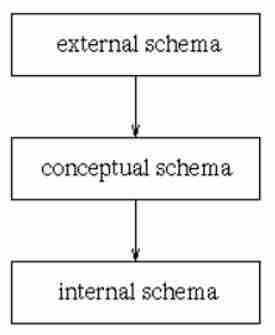Introduction to database management systems
Chapters
A word on architecture
The ANSI/SPARC (American National Standards Institute/Standards Planning and Requirements Committee) suggested three level architecture for DBMS.A database is considered as containing data about an enterprise. The three levels of architecture are three different views of data:
- External - user view of individual
- Conceptual - user view of community
- Internal - physical or storage view

The three-level database architecture allows a clear separation of information meaning (conceptual view) from external data representation and from physical data structure layout. A database system that is able to separate the three different views of data is likely to be flexible and adaptable.
The external level is a view which individual user of database has. This view is often a restricted view of database and the same database may provide a number of different views for different classes of users. In general, end users and even application programmers are only interested in a subset of database. For example, a department head will be only interested in departmental finances and student enrolments but not library information.
The conceptual view is information model of enterprise and contains view of whole enterprise without any concern for physical implementation. In a database, it may be desirable to change internal view to improve performance while there has been no change in conceptual view of the database. The conceptual view is overall community view of database and it includes all information that is going to be represented in database.
The internal view is view about actual physical storage of data. It tells us what data is stored in database and how. At least the following aspects are considered at this level: Storage allocation e.g. B-trees, hashing etc.
The separation of conceptual view from internal view enables us to provide a logical description of database without need to specify physical structures which is often called as physical data independence. Separating external views from conceptual view enables us to change conceptual view without affecting external views which is often called as logical data independence.
Description
This free tutorial covers the basics of database management system to help you with your understanding on the topic, Please note that this tutorial assumes that either you are a beginner or just want to brush up your understanding on DBMS
Tutorial covers the topics below
- What is DBMS?
- Architecture
- Data Models
- Data Schemas
- Data Independence
- Entity-Relation Model Basic Concept
- Entity-Relation Diagram Representation
- Generalization, Aggregation
- Codd's 12 Rules
- Relational Data Model
- Relational Algebra
- Structured Query Language
- Normalization
- Database Joins
- Storage System
- Indexing
- Hashing
- Transaction
- Concurrency Control and Deadlock
- Data Backup and Recovery
Audience
Absolute beginners or students who wish to brush up their understanding on DBMSes
Author: Subject Coach
Added on: 16th Sep 2015
You must be logged in as Student to ask a Question.
None just yet!